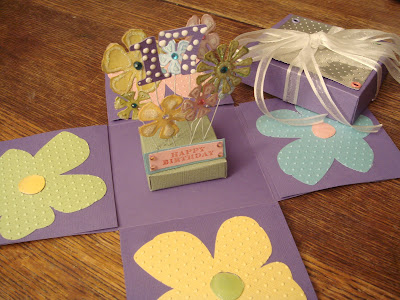It arrived on Friday and since then I've been having a bit of a play.
BOTTOM LINE - I LOVE it. I've had a lot of fun and can see using this a fair bit over the next few months. HOWEVER - there is a learning curve, and you will make mistakes (I certainly did, and my online research indicates others have) and if that bothers you then you won't get along with this. It's a bit messy - but as you get more experience it becomes easier to contain the mess. Or so I've found!
What You Get
The kit comes with the light box, a magnetic clamp which you put the negative and stamp packs in for processing, a brush for cleaning your stamps after they've cooked and a little container used to 'set' the stamps in the final stage.
There's a CD - with a not very impressive video, and some instructions. I'll be honest - I wasn't impressed with the quality of the documentation but I guess it did the job.
You also get 10 medium stamp packs, 10 small stamp packs and a couple of embossing and stencil packs (I haven't tried those yet).
There are 4 pages of Teresa Collins designed stamp negatives (some quite nice ones - and she offers new designs most months on her blog) and 2 inkjet negative sheets to use for your own designs.
My biggest quibble is that 2 sheets of the negative acetate isn't enough. There is a real learning curve with this product and only 2 pages to print designs on inhibits you when you should be experimenting.
My Experience
I decided (foolishly) to start with a custom design and so jumped right in at the deep end!
As there were only 2 pages of negative acetate for printing I figured I shouldn't waste any so designed a full page of stamps. A few text designs (some quotes and a 'handmade' stamp), and a black and white photo (of my parents!) to see how that would work.
I used Craft Artist and created a black background and then used white for the text to create a 'negative'. (When the stamps are made, white areas become solid creating the image.) I used the Imagepac program on the CD to create a negative for the photograph, and then copied and pasted that into Craft Artist. I printed the page and then attempted my first stamp.
Which was a failure!!!
I ended up with a solid piece of plastic because the negative did not fill the clamp space which allowed too much light in!
For my second attempt I used the same negative, but added a frame border around it to block out the excess light.
This was more successful - but far from perfect. I got a stamp that had lost a little detail and had some raggedy edges. Despondent (sort of) I did a bit of research and it seemed that maybe my negatives were not black enough.
To confirm this I made a stamp using one of the Teresa Collins negatives - and sure enough it turned out WAY WAY better. So now I knew I needed blacker negatives.
 I re-print the negatives on a different (cheaper!) printer and tried again.
I re-print the negatives on a different (cheaper!) printer and tried again.Things were looking up!
The next custom stamp I made was definitely more successful and I was really beginning to enjoy myself so made a few more.
The set recommends just using the stamps directly on an acrylic block (using some tape/cling stuff they provide) but after some experimenting I found I got MUCH better results when I put the stamps onto some U-mount or EZ-mount first.
Here are a few stamped images - the clock and the bottom quote were made from Teresa Collins negatives - the other 3 are mine!!
My final experiment this morning was to make the photograph stamp - and overall I have to say I'm pretty impressed!
It's not perfect but it's good and certainly usable.
Here's the original photo and the 'pop art' images I made using my new stamp.
I used Craft Artist to 'cut out' my parents as I felt the background wouldn't work well and then added a border around the image. I used the Imagepac softward to 'invert' the image (make it a negative) and then copied and pasted it back into Craft Artist.
I've got lots of ideas floating around in my head now and am definitely pleased with my new toy!!
Top Tips
If you do take the plunge - my top tips are:
1) the right printer and the right settings for the printer are CRUCIAL (print options should be high quality, specialist paper and greyscale/ black ink only). The negatives that you print MUST block out light, you shouldn't be able to see through the black sections. And black is probably blacker than you think! My first set of negatives looked black enough to me - but they weren't.
The makers of the product recommend a very cheap HP Desk Jet 1000 (£20 at Comet) - which I was lucky enough to have (it was a spare office printer that I almost gave away a couple of months ago!). I wasn't able to get solid enough black with my more expensive Canon printer - but it might have been that I wasn't using the right settings.
2) plan the layout of any page you are printing carefully so that the images are surrounded by enough black ink and will fill the 'clamp'. Light where you don't want it is your enemy.
3) before you make your own stamp - make one using the negatives that come with the kit. (I didn't - wish I had.) That will help you feel confident about the equipment and the timings before you tackle custom designs.


















